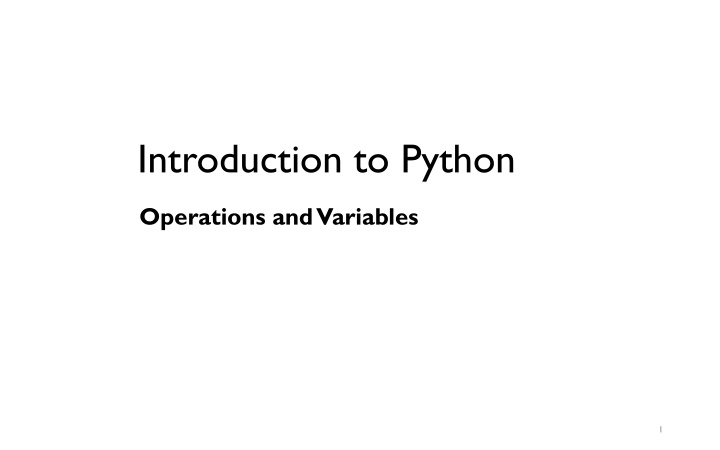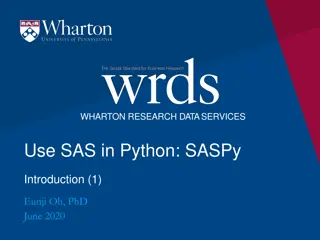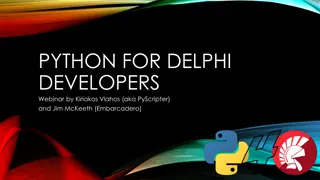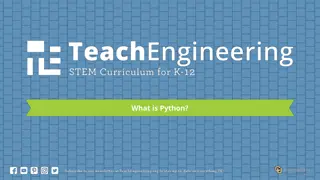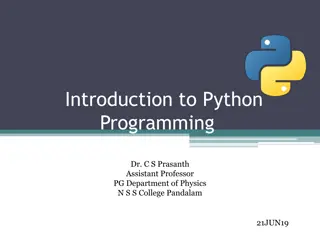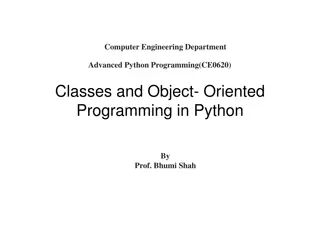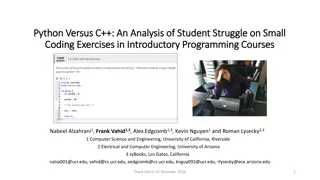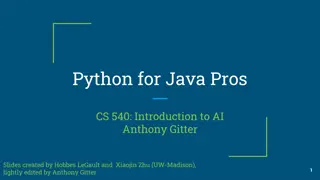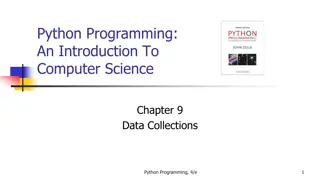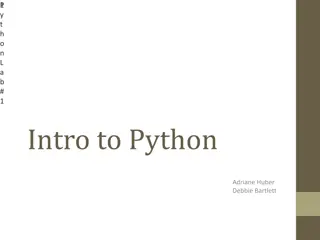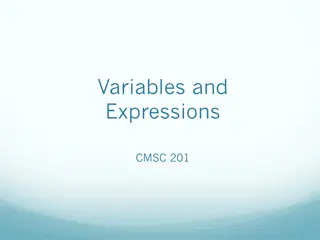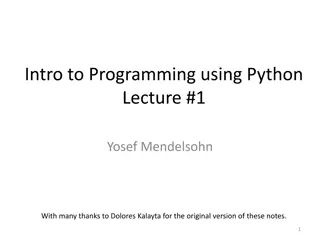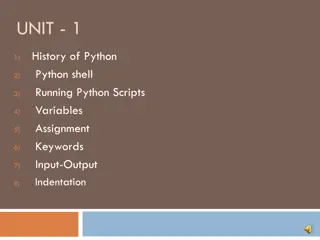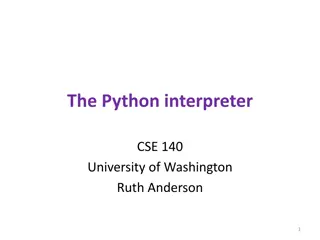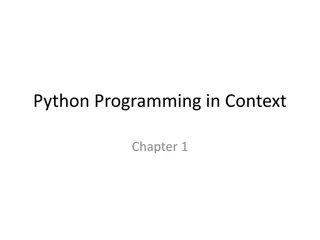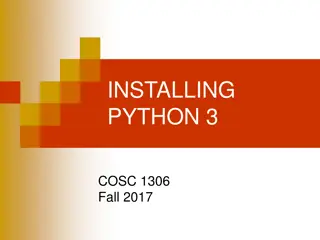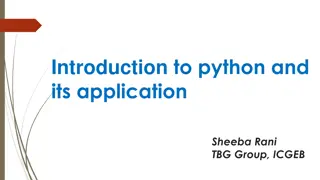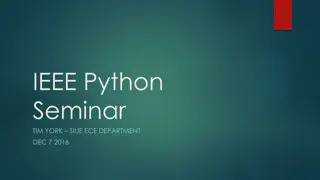Introduction to Python
This content covers essential topics in Python operations and variables, such as arithmetic operations, floor division vs. true division, modulus operator, mixing types, and the usefulness of floor and modulo division. Learn about the differences between true and floor division, how Python handles mixed types in expressions, and practical applications of the modulus operator. Dive into examples and explanations to enhance your understanding of Python's fundamental concepts and operations.
Download Presentation

Please find below an Image/Link to download the presentation.
The content on the website is provided AS IS for your information and personal use only. It may not be sold, licensed, or shared on other websites without obtaining consent from the author.If you encounter any issues during the download, it is possible that the publisher has removed the file from their server.
You are allowed to download the files provided on this website for personal or commercial use, subject to the condition that they are used lawfully. All files are the property of their respective owners.
The content on the website is provided AS IS for your information and personal use only. It may not be sold, licensed, or shared on other websites without obtaining consent from the author.
E N D
Presentation Transcript
Introduction to Python Operations and Variables 1
Topics 1) Arithmetic Operations 2) Floor Division vs True Division 3) Modulo Operator 4) Operator Precedence 5) String Concatenation 6) Augmented Assignment 2
Mixing Types Any expression that two floats produce a float. x = 17.0 10.0 print(x) # 7.0 When an expression s operands are an int and a float, Python automatically converts the int to a float. x = 17.0 10 print(x) y = 17 10.0 print(y) # 7.0 # 7.0 4
True Division vs Floor Division The operator / is true division and the operator // returns floor division(round down after true divide). True divide / always gives the answer as a float. print(23 // 7) # 3 print(3 // 9) print(-4 // 3) # -2 print(6 / 5) print(6 / 3) # 0 # 1.2 # 2.0 NOT 2! 5
Remainder with % The % operator computes the remainder after floor division. 14 % 4 is 2 218 % 5 is 3 3 4 ) 14 5 ) 218 12 20 2 18 15 3 43 Applications of % operator: Obtain last digit of a number: Obtain last 4 digits: See whether a number is odd: 230857 % 10 is 7 658236489 % 10000 is 6489 7 % 2 is 1, 42 % 2 is 0 6
Modulo Operator The operator % returns the remainder after floor division. print(18 % 5) print(2 % 9) print(125 % 10) # 5 print(0 % 10) print(10 % 0) # 3 # 2, if first number is smaller, it's the answer # 0 # ZeroDivisionError 7
Why floor and modulo division are useful Floor division allows us to extract the integer part of the division while the modulo operator extracts the remainder part of the division. Consider the question: How many weeks and days are there in 25 days? Answer: 3 weeks plus 4 days. num_weeks = 25 // 7 # extracting number of weeks print(num_weeks) # 3 num_days = 25 % 7 print(num_days) # 4 # extracting number of days 8
Why the modulo operator is useful If today is a Tuesday, which day is 43 days from today? Answer: 43 divided by 7 is 6 with a remainder of 1. Thus, it will be Wednesday. print(43 % 7) # 1 Even/odd: A number x is even if x % 2 is 0 and odd if x % 2 is 1. num = int(input( Please enter an integer value: )) print(num, 'is even:', num % 2 == 0) Output 1: Please enter an integer value: 4 4 is even: True Output 2: Please enter an integer value: 13 13 is even: False 9
Expressions Find the exact change for 137 cents using quarters, dimes, nickels and cents. Use the least number of coins. How many quarters? 137 // 25 = 5 quarters (Floor Division!) What s leftover? 137 % 25 = 12 cents How many dimes? 12 // 10 = 1 dime What s leftover? 12 % 10 = 2 cents How many nickels? 2 // 5 = 0 nickels. What s leftover? 2 % 5 = 2 cents. How many pennies? 2 // 1 = 2 pennies What s leftover? 2 % 1= 0 cents. Done! 10
Extracting Digits Given a three-digit integer. Extract its the ones, tens and hundreds digits. For example, if the integer is 352. Its ones digit is the 2, its tens digit is the 5 and its hundreds digit is the 3. number = 352 print("ones:", number % 10) number = number // 10 print("tens:", number % 10) number = number // 10 print("hundreds:", number % 10) # ones: 2 # number = 35 (discards last digit) # tens: 5 # number = 3 (discards last digit) # hundreds:3 Note: Modulo 10 (% 10) extracts the last digit. Floor division (// 10) discards the last digit. Later in another lecture, we will see how to generalize this to any number of digits. 11
Extracting Digits Alternatively: number = 352 ones = number % 10 tens = (number // 10) % 10 hundreds = number // 100 print("ones:", ones, "tens", tens, "hundreds:", hundreds) Output: ones: 2 tens: 5 hundreds: 3 12
Exponentiation and Negation x = 2 ** 3 print(x) # 8 Negation is a unary operator. It applies to only one operand. Other operations such as +, -, *, /, //, % are binary operators, they apply to two operands. x = -5 y = --5 print(x) print(y) # -5 # 5 13
Operator Precedence Precedence Operator Operation highest ** exponentiation - negation *, /, //, % multiplication, division, floor division, modulus (left to right) lowest +, - adding, subtraction(left to right) Operators on the same row are applied left to right. Exponentiation, however, is applied right to left. Expressions in parenthesis are evaluated first(PEMDAS). 14
Operator Precedence x = -2 ** 4 print(x) # -16 y = 7 4 * 5 % (1 + 2) print(y) # 5 7 - 4 * 5 % (1 + 2) 7 4 * 5 % 3 7 20 % 3 7 2 5 15
Augmented Assignment An augmented assignment combines an assignment statement with an operator to make the statement more concise. Shorthand variable += value variable -= value variable *= value variable /= value variable %= value Equivalent version variable = variable + value variable = variable - value variable = variable * value variable = variable / value variable = variable % value x = 4 x += 1 print(x) # equivalent to x = x + 1 # 5 16
Augmented Assignment x = 3 x *= 2 + 5 print(x) # 21 number = 5 number *= number print(number) # 25 17
String Concatenation Two strings can be combined, or concatenated, using the + operator: string1 = "abra" string2 = "cadabra" magic_string = string1 + string2 first = "Michael" last = "Smith" full_name = first + " " + last Concatenating a string and a number raises a TypeError. Must first cast the number into a string using str(). apples = "I have " + 3 + "apples" apples = "I have " + str(3) + "apples" # error! # correct! 18
Errors Beginning programmers make mistakes writing programs because of inexperience in programming in general or due to unfamiliarity with a programming language. There are four general kinds of errors: syntax errors, run-time errors, overflow errors and logic errors. The interpreter reads the Python source file and translates it into a executable form. This is the translation phase. If the interpreter detects an invalid program statement during the translation phase, it will terminate the program s execution and report an error. Such errors result from the programmer s misuse of the language. A syntax erroris a common error that the interpreter can detect when attempting to translate a Python statement into machine language. 19
Syntax Errors A syntax erroris a common error that the interpreter can detect when attempting to translate a Python statement into machine language. x = 3 y = x + 5 y + 2 = x print(x z = "hello # SyntaxError # SyntaxError # SyntaxError 20
Run-time Errors A syntactically correct Python program still can have problems. Some language errors depend on the context of the program s execution. Such errors are called run-time exceptionsor run-time errors. We say the interpreter raisesan exception. Run-time exceptions arise after the interpreter s translation phase and during the program s execution phase. Run-time errors will cause the program to immediately terminate. x = 3 y = x + 5 y = w + 1 # Syntactically correct but raises a run-time # error: "name w is not defined" 21
Run-time Errors Here's another example of a run-time error. # Get two integers from the user print('Please enter two numbers to divide.') dividend = int(input('Please enter the dividend: ')) divisor = int(input('Please enter the divisor: ')) # Divide them and report the result print(dividend, '/', divisor, "=", dividend/divisor) The expression dividend/divisor is potentially dangerous. If the user enters, for example, 32 and 4, the program works nicely. If the user instead types the numbers 32 and 0, the program reports an error and terminates. Division by zero is undefined in mathematics, and division by zero in Python is illegal. 22
Run-time Errors Another example of a run-time error is an overflow error. An overflow erroris an error that occurs when a computer attempts to handle a number that is outside of the defined range of values. print(2.0 ** 10000) # OverflowError: 'Result too large' 23
Logic Errors The interpreter can detect syntax errors during the translation phase and uncover run-time exceptions during the execution phase. Both kinds of problems represent violations of the Python language. Such errors are the easiest to repair because the interpreter indicates the exact location within the source code where it detected the problem. A logic error is a mistake in the algorithm or program that causes it to behave incorrectly or unexpectedly. A logic error is subtle and will not cause the program to terminate. 24
Logic Errors Consider the effects of replacing the expression dividend/divisor with divisor/dividend. The program runs, and unless the user enters a value of zero for the dividend, the interpreter will report no errors. However, the answer it computes is not correct in general. The only time the program will print the correct answer is when dividend equals divisor. The program contains an error, but the interpreter is unable detect the problem. An error of this type is known as a logic error. 25
AP Exam Info 26
AP Exam Info Note that there is no floor division on the AP exam. On the AP, like Python, the operator / is true division. 27
Lab 1: Modulo Operator Create a new repl on repl.it. Write code to match the following console output. Underline numbers are user inputs; you must use the input() function. Create the following variables: ones, tens and hundreds Enter a three-digit number: 245 The sum of the digits of 245 is 11. Create the following variables: quarters, dimes, nickels and pennies. Enter amount in cents: 137 Number of quarters: 5 Number of dimes: 1 Number of nickels: 0 Number of pennies: 2 28
References 1) Vanderplas, Jake, A Whirlwind Tour of Python, O Reilly Media. This book is completely free and can be downloaded online at O reilly s site. 29
